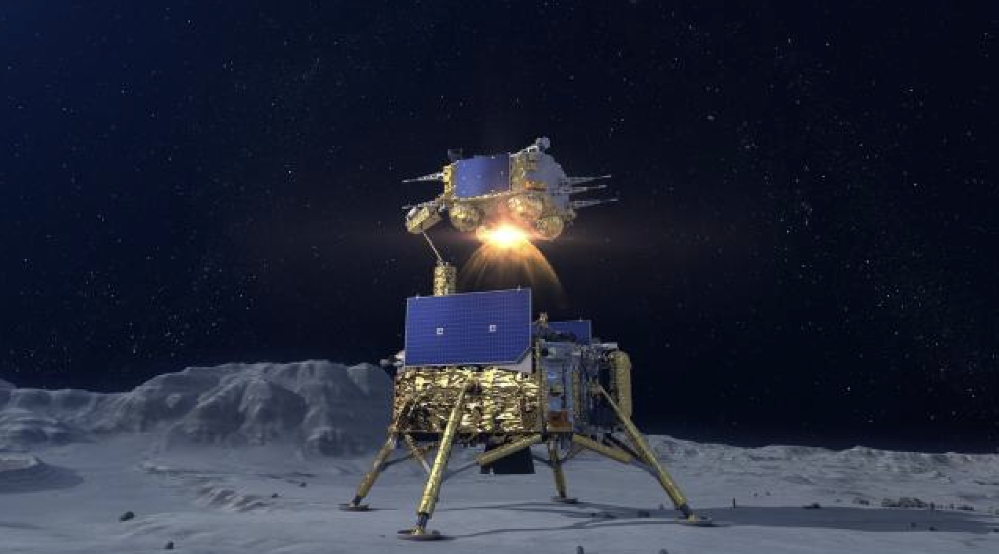Chang’e 6 mission highlights HK’s prowess in sci-tech research ![]()
![]()
By Tu Haiming
Lunar exploration reached another significant milestone with Chang’e 6’s return to Earth bearing lunar samples on Tuesday.
President Xi Jinping extended his warm congratulations and sincere greetings to the Chang’e 6 mission command and all those who participated in the mission, noting that for the first time in human history, Chang’e 6 has successfully collected samples from the moon’s far side and returned to Earth, marking another landmark achievement in China’s journey to becoming a space and sci-tech power.
The overwhelming success of the Chang’e 6 mission brought both pride and joy to Hong Kong residents as the city contributed to the mission, and its contribution will go down in history. The Surface Sampling and Packing System used in this mission was jointly developed by a Hong Kong Polytechnic University (PolyU) research team and the China Academy of Space Technology. As Hong Kong prepares to celebrate the 27th anniversary of its reunification with the motherland, its residents are rejoicing, along with their mainland compatriots, at this feat and are cheering the city’s contribution to the successful moon exploration journey.
The key task of Chang’e 6 was to collect samples from the far side of the moon, which could not have been achieved without the help of the Surface Sampling and Packing System codeveloped by the PolyU research team. Based on experience gained in previous aerospace projects, the PolyU research team had made multiple improvements to the device used in Chang’e 6 to expedite the sampling task.
Since PolyU joined the country’s space mission in 2010, it has collaborated with the China Academy of Space Technology in developing space instruments, assisting in the assessment of suitable landing sites with the use of advanced topographic surveying technology, and has successively contributed to the success of Chang’e 3, Chang’e 4, and Chang’e 5 lunar explorations and the Tianwen 1 Mars mission.
The achievement of Chang’e 6 corroborates PolyU’s world-class scientific research capability and embodies the country’s full recognition of the city’s sci-tech undertakings. How the Chang’e lunar explorations benefited from Hong Kong is widely discussed in public discourse. Many have come to realize that besides the city’s glittering reputation as a free port, international metropolis and international financial center, Hong Kong also shines in scientific research. It goes without saying that Hong Kong would not have been able to take part in the space mission without the country’s progress in the aerospace industry. The country provides the special administrative region with opportunities to flex its muscles in science and technology.
Geologists at the University of Hong Kong have also been involved in lunar exploration projects. They have recently worked with counterparts at home and abroad to study the landing area of Chang’e 6 at the Apollo Basin, where they spotted frequent but varied volcanic activity, reconstructed its volcanic history, and provided a geological framework that serves as an important reference for analyzing the collected samples. The success of the Chang’e lunar missions has instilled a sense of confidence in Hong Kong scientists for space exploration. Yung Kai-leung, director of the Research Center for Deep Space Explorations at PolyU, said that Hong Kong should devote more effort to research and development to support the country’s future space explorations to the moon, Mars, and beyond. Hong Kong scientists see it as their dream, their duty, as well as their mission.
As Hong Kong excels in many areas, its prowess in scientific research is often overlooked. The city’s contribution to the success of Chang’e 6 has drawn attention to the city’s capacity in sci-tech development.
Hong Kong boasts abundant scientific research resources, with five of its universities ranking among the global top 100, which is no mean feat. The city also has two medical schools ranking among the top 50 globally, as well as 16 State Key Laboratories, with six Hong Kong Branches of Chinese National Engineering Research Centers.
Hong Kong’s innovation capability is among the best in the world. In the 2023 Global Innovation Index released by the World Intellectual Property Organization, the Shenzhen-Hong Kong-Guangzhou science and technology cluster was ranked second globally for the fourth consecutive year, with Hong Kong retaining fifth place in Asia and 17th among 132 economies surveyed.
The success of Chang’e 6 should serve as an inspiration for Hong Kong society to make full use of the city’s competitive edge to promote technological innovation. For example, Hong Kong has solid advantages in life and health technology, artificial intelligence, data science, and advanced manufacturing, which can be further developed for economic benefits. To this end, Hong Kong’s research institutions can expand cooperation with world-class research institutions to develop an open sci-tech platform that facilitates the course of scientific development and avoids unnecessary detours; they should also expand cooperation with their mainland counterparts to complement each other’s strengths, thereby raising the bar of scientific research to new heights; and they should collaborate with advanced manufacturing enterprises to commercialize their research and development results.
By complementing the strengths of all relevant parties and focusing on areas where it enjoys advantages, the city can find a shorter and smoother path to advance technological development for socioeconomic benefits.
In his opening remarks at this year’s National Security Education Day commemoration in Hong Kong, Xia Baolong, director of the Hong Kong and Macao Work Office of the Communist Party of China Central Committee, emphasized the need for Hong Kong society to adopt a new mindset, and explore new ways and new approaches to facilitate the city’s development. The successful Chang’e 6 mission points to a feasible direction for Hong Kong to pursue its own development and achievements while contributing to the country’s development.
The author is vice-chairman of the Committee on Liaison with Hong Kong, Macao, Taiwan and Overseas Chinese of the National Committee of the Chinese People’s Political Consultative Conference and chairman of the Hong Kong New Era Development Thinktank. The views do not necessarily reflect those of Bauhinia Magazine.
https://res.youuu.com/zjres/2024/6/30/Jot1XCjUaoNgkkubRu0H0xNJX8YHq6ADkiR.png











掃描二維碼分享到手機














